What is the link between video gaming and gambling?
What is the link between video gaming and gambling?
Snapshot Series - Issue 7
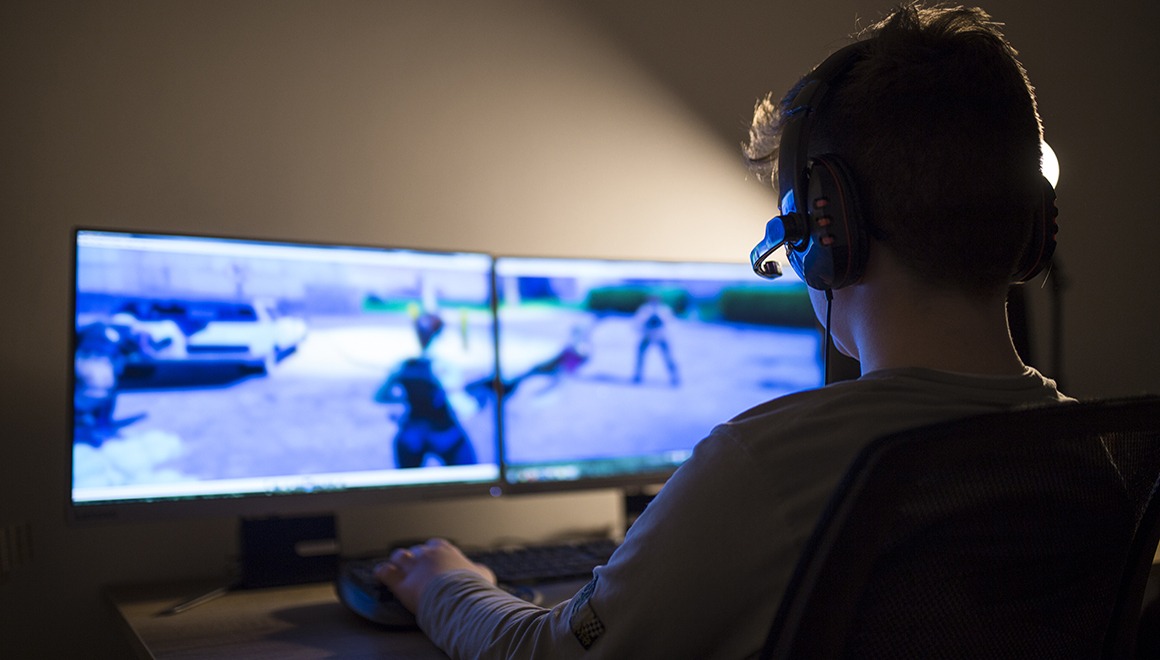
What do we know?
Video gaming is a popular form of entertainment in Australia. Gaming and gambling are defined as separate activities but they share similarities in appearance, interactive features and elements of skill and chance. Games that structurally resemble traditional gambling activities ('gambling-like' video games) are commonly referred to as 'simulated gambling'. Simulated gambling appears in many forms in video games but social casino games are the most common.
Previous research has found a link between video gaming and gambling. Simulated gambling products have the potential to normalise and encourage monetary gambling, especially among children and young people, yet few studies have examined this relationship. Gambling can lead to a range of negative consequences or gambling harms, including financial, relationship, social, health and emotional/psychological harms.
What can we learn?
This snapshot examines the link between playing video games during adolescence and gambling as a young adult. It explores whether young people who played video games frequently or played certain types of games in their adolescent years started real money gambling1 when they reached the legal age for gambling in Australia (18 years). We examine three main questions: (1) What are the effects of daily video gaming on real money gambling? (2) What are the effects of playing simulated gambling games on real money gambling? (3) What are the other main risk factors associated with gambling among young people?
In focus
This snapshot follows children from when they were 12-13 years old to when they were 18-19 years old. They reported on their experiences of video gaming (using a computer or computer-like device to play games) as they aged from 12-13 years (in 2012) to 16-17 years in 2016. Their gambling experiences were captured when they were aged 16-17 years (2016) and again at 18-19 years (2018). Their parents were also asked about their own gambling activities in 2016.
Video gaming among young Australians
Playing video games is popular among young Australians and many children play video games frequently and for long hours.
At age 12-13 years almost all participants (96% males; 90% females) reported playing video games, and 53% of males and 36% of females played almost every day. Participation in video gaming and daily video gaming declined as adolescents transitioned through their teenage years (see Figure 1).
Boys were more likely to engage in video gaming and daily video gaming during adolescence than girls (Figure 1). At age 12-13 years, 53% of boys played video games daily and engagement remained high (47%) at age 16-17. The proportion of girls who played video games daily declined substantially from 36% at age 12-13 years to 20% at age 16-17.
Figure 1: Video gaming among Australian adolescents
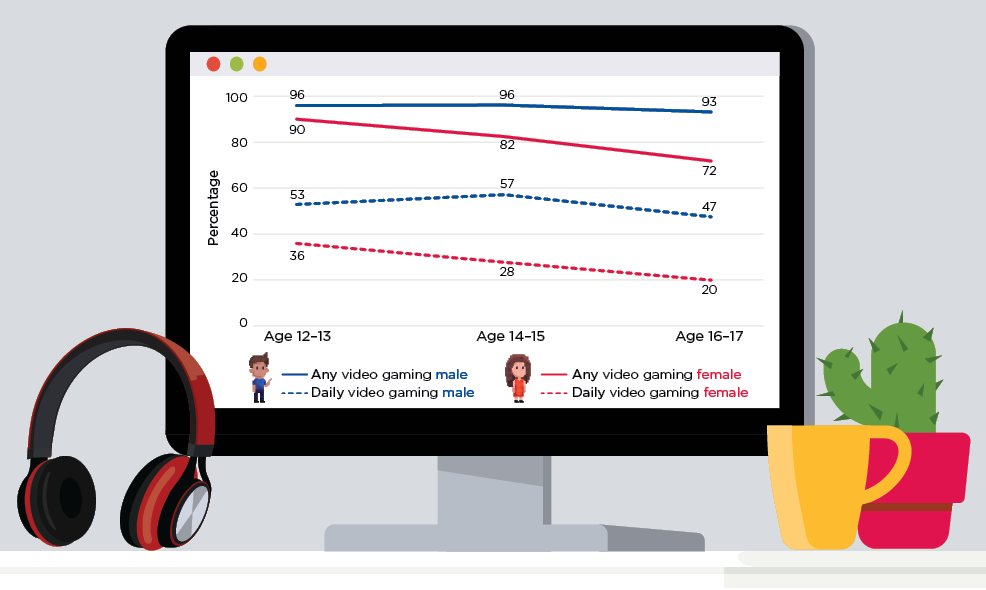
Note: LSAC K cohort, Wave 5 (n = 3,850), Wave 6 (n = 3,317) and Wave 7 (n = 2,947), weighted.
Some video games contain features that resemble or function like commercial gambling activities (examples are shown in Figure 2). Some resemble poker machines or 'pokies' and others resemble casino table games where the players can interact with other players via internet and social network sites (e.g. Facebook). According to LSAC, at age 16-17 years, one in five (20%) adolescents played simulated gambling games (e.g. Zynga Poker, Slotomania and Big Fish Casino). Engagement with simulated gambling games was more common among boys (24%) than girls (15%).
Video games that simulate gambling experience are often classified M (mature), but parents have called for tougher classifications (20% suggested MA15+ and 40% suggested R 18+).2 A review of Australian classification regulations recommended that the classification scheme be updated.3
Figure 2: Simulated gambling


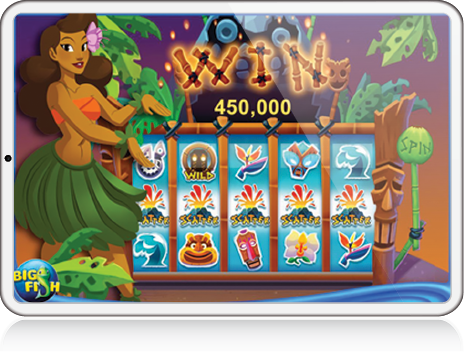
Gambling participation among young Australians
Participation in real money gambling increased significantly when young people reached the legal age to gamble (18 years; Figure 3). Approximately 16% of young people aged 16-17 participated in under-age gambling (most commonly private betting, 9%); two years later (aged 18-19), gambling increased to approximately 46%. At age 18-19 years, the five most common products to gamble on were: (1) poker machines ('pokies'; 30%); (2) instant scratch tickets ('scratchies'; 15%); (3) casino table games (13%); (4) betting on horse or dog races (12%); and (5) betting on sports (12%).
Young men (at age 18-19 years) were more likely to gamble than young women (51% compared to 40%; Figure 4); including on poker machines, sports betting, casino table games, race betting and private betting. Young women were more likely to gamble on scratchies and bingo than young men. Research suggests that gambling on casino table games, poker machines and race and sports betting are linked to higher frequency of gambling and increased risk of problem gambling.4
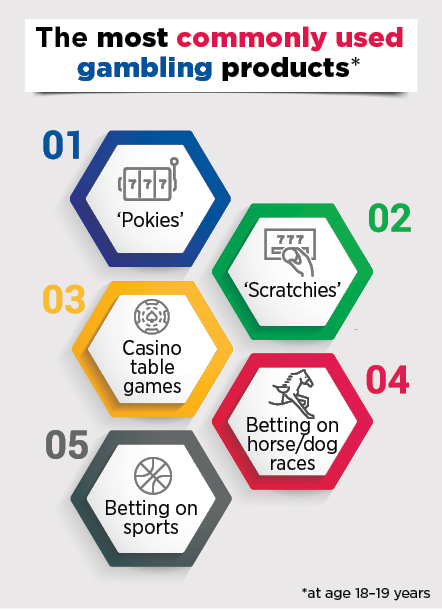
Figure 3: Gambling participation by product and age
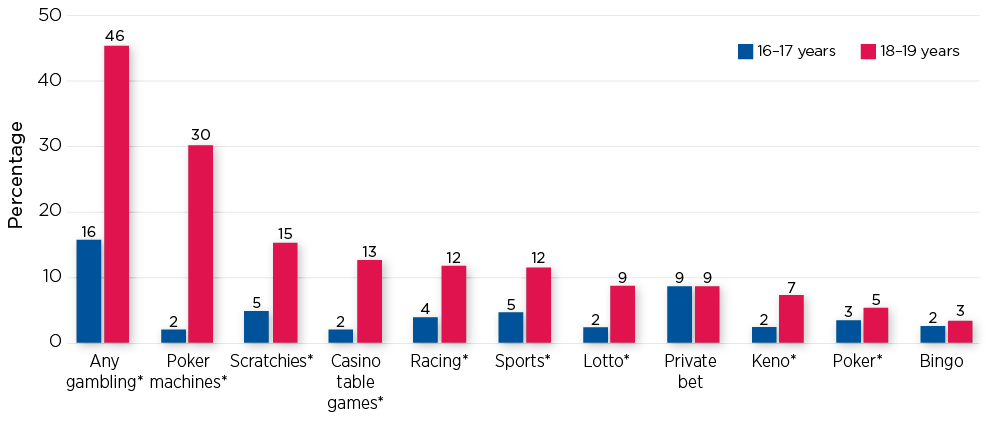
Notes: LSAC K cohort, Waves 7 and 8, weighted. The asterisk (*) denotes a statistically significant difference in results between the ages 16-17 and 18-19 (p < 0.05). The sample size ranged from n = 2,937 to n = 2,466.
Figure 4: Gambling participation by product and gender
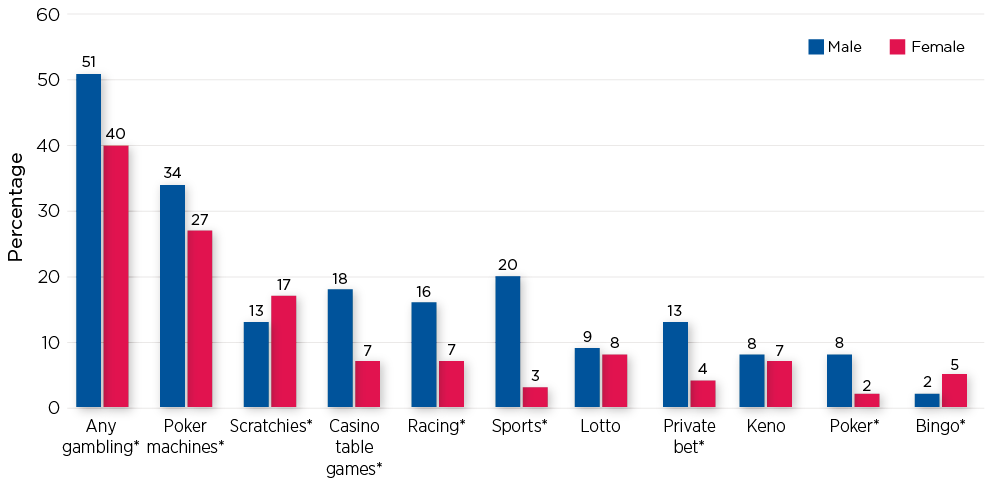
Notes: LSAC K cohort, Wave 8, weighted. The asterisk (*) denotes a statistically significant difference in results between male and female (p < 0.05). The sample size ranged from n = 2,492 to n = 2,466.
Gambling-related problems among young Australians
The proportion of young people at risk of, or already experiencing, gambling-related problems increased more than fourfold between the ages of 16-17 and 18-19. Gambling-related problems were assessed among those who had gambled in the past year using the Problem Gambling Severity Index (PGSI).5 According to the PGSI score (Figure 5), 2% of 16-17 year olds were classified as being at risk of, or already experiencing, gambling-related problems (i.e. a score of 1+ on the PGSI). Two years later, about 9%, or 54,000 18-19 year olds, were classified as being at risk of, or already experiencing, gambling-related problems. At-risk gambling behaviour was more prevalent among young men (13%) than young women (4%).
Figure 5: Problem Gambling Severity Index (PGSI) by age
Notes: LSAC K cohort, Wave 7 (n = 2,934) and Wave 8 (n = 2,488), weighted. The ‘at risk of or experiencing problems’ category includes respondents classified as experiencing either low-risk gambling, moderate-risk gambling or problem gambling (i.e. any risk).
The link between video gaming and real money gambling
We examined the association between engaging in video gaming during adolescence and monetary gambling (top 5 gambling products by participation) in young adulthood.
Generally, we found no statistically significant association between daily video gaming (at age 16-17) and monetary gambling (at age 18-19). The exception was sports betting, which was more common among young people who played video games daily (Figure 6).
However, young people who played simulated gambling games (e.g. Zynga Poker, Slotomania and Big Fish Casino) as adolescents (aged 16-17) had statistically significant positive associations with spending money on gambling as adults (aged 18-19; see Figure 7). It is possible that this association is not causal (i.e. playing simulated gambling games does not directly cause or increase the risk of gambling); for example, it might be that there are common underlying causes (such as personality traits) for both behaviours.
To investigate this possibility, we conducted more sophisticated statistical modelling.6 This confirmed that there were no causal effects of daily video gaming on gambling, including sports betting. However, our causal analyses did find a statistically significant pathway between playing simulated gambling games at age 16-17 and gambling on casino table games, betting on racing and betting on sports at age 18-19 years (Table 1). It is important to note that, in this study, engagement in simulated gambling games did not involve spending money. Even without monetised gaming, we observed a causal link between playing simulated gambling games during adolescence and gambling with real money as a young adult.
Table 1 shows that adolescents who played simulated gambling games had a 40 percentage points higher probability of gambling with money as adults, compared to adolescents who did not play simulated gambling games. By product, adolescents who played simulated gambling games had a higher probability of 26 percentage points of participating in casino table games, of 29 percentage points of betting on racing, and of 21 percentage points of betting on sports as adults.

These findings suggest that young people who played video games daily in their adolescent years (aged 16-17 years) were not necessarily more likely to gamble as adults (aged 18-19 years), but that playing simulated gambling games (such as Zynga Poker, Slotomania and Big Fish Casino) did increase the likelihood of real money gambling.
Figure 6: Daily video gaming and gambling participation by product (top 5 products)
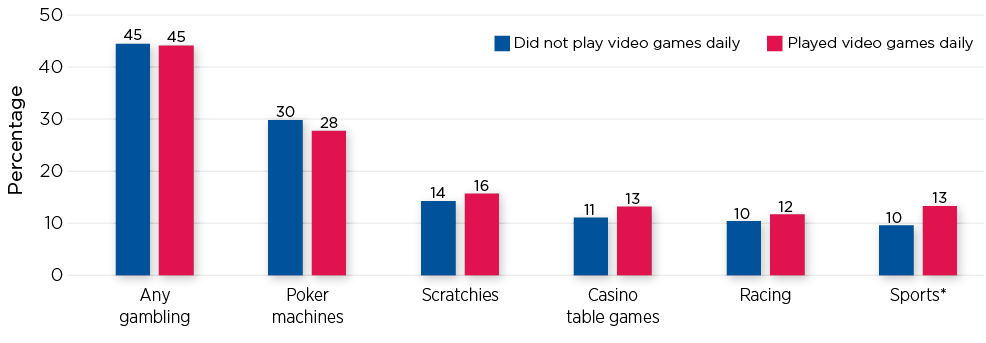
Notes: LSAC K cohort, Waves 7 and 8, weighted. The asterisk (*) denotes statistically significant differences between the two groups (p < 0.05). The sample size ranged from n = 2,225 to n = 2,205.
Figure 7: Playing simulated gambling games and gambling participation by product (top 5 products)

Notes: LSAC K cohort, Waves 7 and 8, weighted. The asterisk (*) denotes statistically significant differences between the two groups (p < 0.05). The sample size ranged from n = 2,222 to n = 2,202.
| Any | Scratchies | Casino table games | Pokies | Racing | Sports | |
|---|---|---|---|---|---|---|
| Marginal effects | Marginal effects | Marginal effects | Marginal effects | Marginal effects | Marginal effects | |
| Playing simulated gambling games (aged 16-17) | 0.40** | 0.28 | 0.26*** | 0.21 | 0.29*** | 0.21*** |
| [0.17] | [0.17] | [0.08] | [0.17] | [0.05] | [0.07] | |
| Observations | 1,559 | 1,551 | 1,545 | 1,553 | 1,545 | 1,550 |
Notes: Sequential bivariate probit models were estimated. *** p < 0.01, ** p < 0.05, * p < 0.1. Standard errors in brackets. Marginal probabilities are computed with y = Pr(Playing simulated gambling games at age 16-17 = 1, Gambling at age 18-19 = 1). Only main variable is reported. See the supplementary materials for further details.
Other factors associated with gambling among young Australians
Some notable factors were associated with gambling among young adults. For example, in regression analyses we found that young adults had a 10 percentage points higher probability of gambling if their parent/s also gambled. Alcohol use was also found to be a risk factor; compared to young adults who drank 10 drinks or less, young adults who drank more than 10 drinks during the last seven days had a 12 percentage points higher probability of participating in gambling.
We also investigated whether there were any gender differences in the relationship between simulated video gaming and gambling (Figures 8 and 9). Young men who played simulated gambling games as adolescents had statistically significant positive associations with gambling in all of the top 5 products as adults whereas young women only showed statistical significance in any gambling. Unfortunately, we do not have enough observations to conduct more sophisticated causal analysis by gender, and further research is required to make conclusive statements about the gender effects.
Figure 8: Playing simulated gambling games and gambling participation by product (top 5 products; male)

Notes: LSAC K cohort, Waves 7 and 8, weighted. The asterisk (*) denotes statistically significant differences between the two groups (p < 0.05). The sample size ranged from n = 1,100 to n = 1,088.
Figure 9: Playing simulated gambling games and gambling participation by product (top 5 products; female)
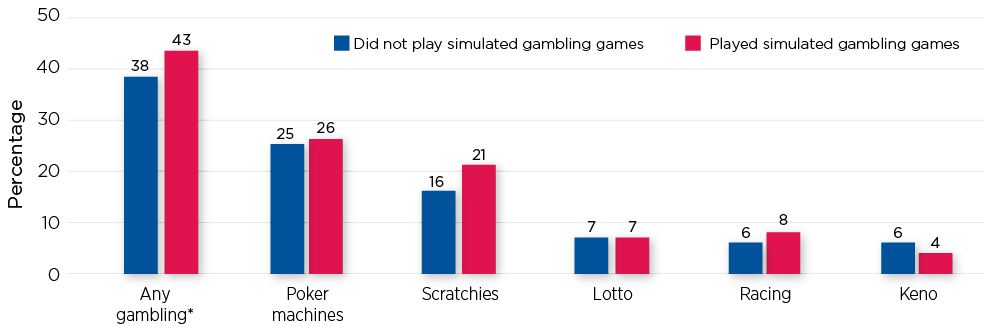
Notes: LSAC K cohort, Waves 7 and 8, weighted. The asterisk (*) denotes statistically significant differences between the two groups (p < 0.05). The sample size ranged from n = 1,122 to n = 1,113.
Implications for policy and practice
Recent estimates suggest that Australians lose approximately $25 billion on legal forms of gambling every year, representing the largest per capita losses in the world.7 Gambling can result in the loss of time, money, or both, and gambling losses can lead to a range of negative consequences or gambling harms, ranging from financial, relationship or psychological issues to serious legal or health issues.
We found that playing video games daily at age 16-17 years did not lead to gambling at age 18-19 years; however, there was a causal link between playing simulated gambling games (e.g. Zynga Poker, Slotomania and Big Fish Casino) during adolescence and gambling participation as a young adult. Parent gambling and higher levels of alcohol consumption were found to be risk factors for monetary gambling as young adults. Simulated gambling games appear to have more impact on young men than young women.
The experience of gambling problems among young people were also examined and we found that the proportion of young people who would be classified as being at risk of, or already experiencing, gambling problems (PGSI score > 0) increased from 2% (at age 16-17) to 9% (at age 18-19).
Findings from this research can help to inform the classification and regulation of different types of video games in Australia, and the development of tailored and targeted health promotion messages for young people and their parents about the potential harms of gambling. The links between gaming and gambling among LSAC participants will continue to be monitored in future waves to better understand changes in participation and harm over time.
Further details
Technical details of this research, including description of measures, detailed results and bibliography are available to download as a PDF [114 KB]
About the Growing Up in Australia snapshot series
Growing Up in Australia snapshots are brief and accessible summaries of policy-relevant research findings from Growing Up in Australia: The Longitudinal Study of Australian Children (LSAC). View other Growing Up in Australia snapshots in this series.
1 In this snapshot, gambling refers to spending money on the following products in the past 12 months: (1) instant scratch tickets ('scratchies'); (2) bingo; (3) lotto or lottery games; (4) Keno; (5) private betting with friends or family; (6) poker; (7) casino table games; (8) poker machines ('pokies'); (9) betting on horse or dog races; and (10) betting on sports.
2 Department of Communication and the Arts. (2018). 2018 classification survey report: Loot boxes and simulated gambling in games. Canberra: Commonwealth of Australia. Retrieved from www.classification.gov.au/sites/default/files/2019-10/classification-sur...
3 Browne, B. (2020). Gambling on games: How video games expose children to gambling. Discussion paper. Canberra: Australia Institute. Retrieved from www.infrastructure.gov.au/sites/default/files/submissions/centre-for-res...
4 Productivity Commission. (2010). Gambling (Productivity Commission Inquiry Report no. 50). Canberra: Commonwealth of Australia. Retrieved from www.pc.gov.au/inquiries/completed/gambling-2010/report
5 Ferris, J., & Wynne, H. (2001). The Canadian problem gambling index: Final report. Ottawa, ON: Canadian Centre on Substance Abuse. See further details in the supplementary materials.
6 We estimated sequential bivariate probit models to deal with endogeneity (see the supplementary materials for further details).
7 Queensland Government Statistician's Office, Queensland Treasury. (2021). Australian gambling statistics, 36th edition, 1993-94 to 2018-19. Brisbane: Queensland Treasury.
Acknowledgements
Authors: Dr Kei Sakata and Dr Rebecca Jenkinson
Series editors: Dr Tracy Evans-Whipp and Dr Bosco Rowland
Copy editor: Katharine Day
Graphic design: Lisa Carroll
This research would not have been possible without the invaluable contributions of the Growing Up in Australia children and their families.
Website: growingupinaustralia.gov.au
Email: [email protected]
The study is a partnership between the Department of Social Services and the Australian Institute of Family Studies, and is advised by a consortium of leading Australian academics. The Australian Bureau of Statistics were also partners of the study until 2022, with Roy Morgan joining at this point. Findings and views expressed in this publication are those of the individual authors and may not reflect those of the Australian Institute of Family Studies, the Department of Social Services, the Australian Bureau of Statistics or Roy Morgan.
Featured image: © GettyImages/Milan_Jovic
Publication details
Sakata, K., & Jenkinson, R. (2022). What is the link between video gaming and gambling? (Growing Up in Australia Snapshot Series, Issue 7). Melbourne: Australian Institute of Family Studies.











